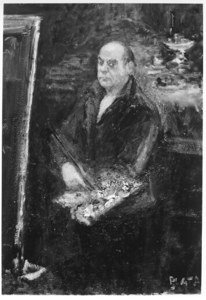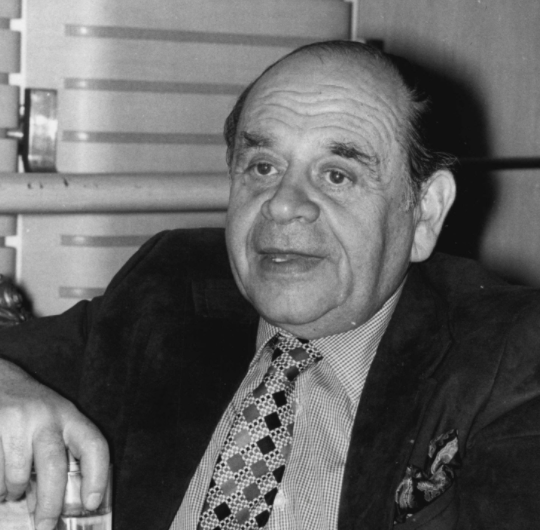Almost thirty years ago, over 200 paintings by Lithuanian artist Arbit Blatas, including a self portrait, were stolen from a storage unit rented by the artist and his wife in New York City. Most of those paintings are still missing today.
Where The Theft Happened
In early 1995, artist Arbit Blatas and his wife, famed mezzo-soprano Regina Resnik, who were residents of New York City, were renting one of the 3,000 storage bins at Manhattan Mini Storage at 543 West 43rd Street in Manhattan. Blatas and his wife had used their unit to store part of their art collection since their marriage in 1975.
How the Theft Happened
Little is known about the actual theft from the storage unit. On January 2, 1995, Mr. Blatas and Ms. Resnick went to their storage unit, which they had not visited since March 1994, to retrieve some paintings for an exhibition in California. When they were not able to open the padlock, they had the lock cut and discovered that their storage space had been completely emptied out. In addition to Blatas’ self portrait, the works stolen included:
- Portraits of Regina Resnik in some of her well-known opera roles, such as Dame Quickly in Verdi’s “Falstaff,” the Old Prioress in Poulenc’s “Dialogues of the Carmelites,” the title role in Bizet’s “Carmen,” and the Nurse in Richard Strauss’ “Die Frau ohne Schatten”
- “The Threepenny Opera” paintings, a series of 60 paintings that Mr. Blatas had worked on for over 50 years after seeing the original production of the German “play with music” by Bertolt Brecht and Kurt Weill in Berlin
- Portrait of Joel Grey as the Emcee in Kander and Ebb’s “Cabaret,” with whom Ms. Resnick had starred as Fraulein Schneider in the 1988 Broadway production
- Portrait of violinist Isaac Stern
- Portrait of violinist, violist and conductor David Oistrakh
- Portrait of cellist and conductor Mstislav Rostropovich
- Portrait of opera star Joan Sutherland
- Portrait of Blatas’ mother that he had painted at age 17 before she had been taken to, and died in, a Nazi concentration camp
- Sketches and drawings by Pisarro, Lipschitz, Toulouse-Lautrec, Boudin and Vuillard
This theft appeared to be one in a string of storage unit thefts in the early 1990s. A break in the case came in April 1995 when a Connecticut antiques collector saw an announcement in an antique newsletter about a Long Island auction that included works by Arbit Blatas. The collector notified the Manhattan-based International Foundation for Art Research (“IFAR”), unfortunately now defunct, and IFAR contacted the New York city police department.
The two New York city detectives working the case learned that a 1950 Blatas painting of the wife of artist Maurice Asselin had already been sold at auction. By tracing the consignor of that painting, they were able to work backwards to the burglar. According to the detectives, they traced the thefts to a man who had gained access to the storage warehouse by renting space on the same floor, and he was then able to view the contents of other units by looking through open grids of the units’ ceilings.
As a result of the investigation, a very small percentage of Blatas’ stolen artwork was recovered – a Paris landscape, an interior painting and a sketch from “The Threepenny Opera” by Blatas, two Pisarro sketches, a Lipschitz and the Boudin. The Vuillard drawing had been sold at auction by Sotheby’s in February 1995, approximately one month after the discovery of the theft.
How to Identify This Missing Piece of History
Arbit Blatas’ Self Portrait, showing the artist seated in front of a painting on an easel with a palette in his hand, is an oil on canvas, measuring 74 inches by 54 ½ inches. It is signed by Blatas on the lower right of the painting.

Why This Missing Piece of History is Important
Arbit Blatas (Nicolai Arbitblatas), was born in Kaunas, Lithuania in 1908. In 1921, as a teenager, he fled the communist revolution to Germany, where he studied for several years. He then went to Paris where, at the age of 21, he became the youngest member of the School of Paris. Some of his works from that time period were acquired by the Galerie Nationale du Jeu de Paume in 1932.
At that time, his colleagues and friends, many of whom he painted and sculpted, included Soutine, Picasso, Utrillo, Braque, Zadie, Léger, Derain, Vuillard, Matisse, Dufy and Cocteau. Today, his life-sized bronzes of Chaïm Soutine and Jacques Lipchitz are installed in Montparnasse and the garden of Hotel de Ville, respectively. His first Paris exhibition was at Galerie Van Leer in 1933, and he exhibited at the Pierre Matisse Gallery in New York in 1935.
Blatas fled to the United States from Nazi-occupied Europe in 1941 and became an American citizen. That same year, his parents were deported from Lithuania and taken to concentration camps. His mother died in Stutthof. His father survived the Dachau and, after the war, Blatas brought him to the United States.

As a result of his tragic personal history, Blatas memorialized the Holocaust in many of his works. He created four public bas-relief memorials, known as “The Monument of the Holocaust,” that are on display in Lithuania, the United States, France and Italy. The first edition was installed in the Venetian Ghetto in 1980; the second was placed at the Mémorial du Martyr Juif Inconnu in Paris in 1981; the third was installed at Oe Dag Hammarskjold Plaza across from the United Nations in New York in 1982; the last was donated by his wife for the consecration of a memorial in Kaunas, Lithuania, the town from which his parents had been deported.
During the 1970s and 1980s, Blatas entered the world of opera in collaboration with his wife, mezzo-soprano Regina Resnik. He designed costumes and scenery for numerous opera productions, including: “Elektra” for Teatro La Fenice in Venice, Teatro São Carlos in Lisbon, Opéra du Rhin in Strasboug; “Carmen” for Hamburg State Opera; Salome for Teatro São Carlos; “The Queen of Spades” for Vancouver Opera and the Sydney Opera House; and “Falstaff” for Teatr Wielki in Warsaw, Teatro La Fenice, Teatro São Carlos and Festival of Madrid.
Blatas’ paintings had a number of major exhibits in the 1980s and 1990s, with several of those exhibitions dedicated to his School of Paris works, including at the Musée Bourdelle in Paris in 1986 and at the Musée des Années Trente in Boulougne-Billancourt in 1990. During his lifetime, Blatas received numerous honors and awards, including Chevalier and Officier de la Légion d’honneur from France, Medal of Masada from Israel, Gold Medal of Honor, City of Venice, Presidential Medal of Italy and Commander Cross of the Order of Merit of Lithuania.
French art critic Jean Bouret beautifully described Blatas’ work: “He is color, his palette is color, exuberant and sensual, as is the man.”
Blatas died in April 1999 at the age of 90. In 2008 and 2009, in celebration of the 100th anniversary of his birth, a retrospective of his work, bringing together the major themes and media of his work was held at the Hebrew Union College-Jewish Institute of Religion in New York. Artist and writer Richard McBee described this exhibition:
“Blatas was a survivor whose artwork manages to hold together two terribly contradictory sensibilities: Culture and barbarism. What this exhibition makes abundantly clear is that Arbit Blatas’s work, all aspects of it, never allows us to forget.
Arbit Blatas: Centennial Tribute
What to Do if You Know Where This Missing Piece of History Is
If you recognize Arbit Blatas’ Self Portrait, have any information about it, or know its whereabouts, please call us at 1-202-240-2355 or send us an email at contact@arguscpc.com.
